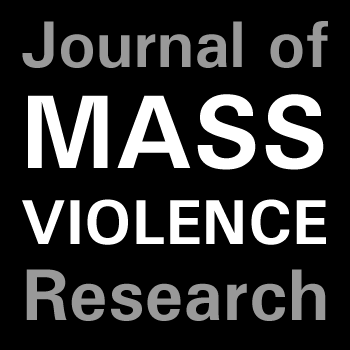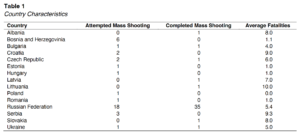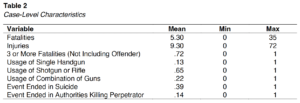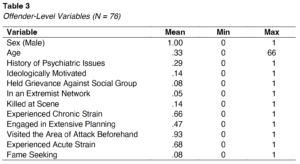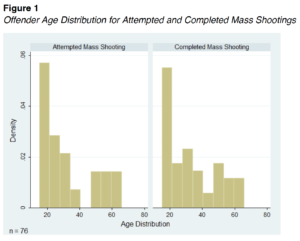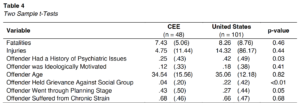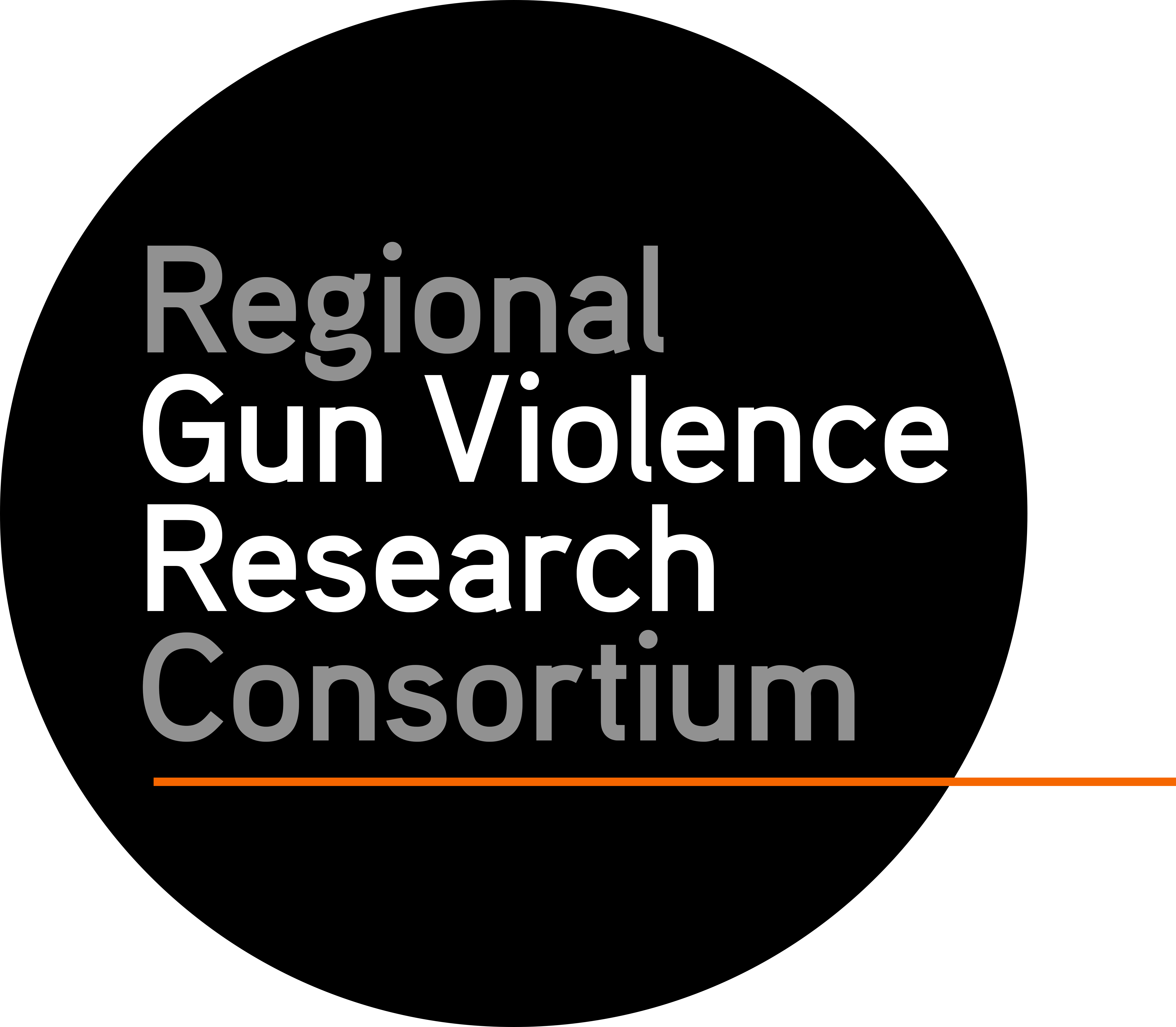SHARE THIS ARTICLE
Do Mass Shootings in Central and Eastern Europe Differ from U.S. Mass Shootings? Insights from the MSCEE Data Set
School of International Relations and Diplomacy, Anglo-American University
Article History: Received July 1, 2022 | Accepted October 31, 2022 | Published Online February 6, 2023
ABSTRACT
Since transitioning out of communist socio-political orders, more than a dozen Central and Eastern European (CEE) countries have experienced mass shootings. To date, scholars have yet to identify a sample of cases that occurred throughout these regions of the world. This study puts forward the first collection of data on attempted and completed mass shootings through introducing 76 cases that occurred in 15 countries from 1993 to 2021. Data comprise 24 variables including offender characteristics of age, sex, motivation, life experiences, mental illness history as well as case-level characteristics including shooting type, location, fatality and injury counts, along with motivational factors including fame seeking and extremism. These data are presented for public access and are encouraged to be used for research triangulation and cross-national social inquiry on mass murder.
KEYWORDS
Central Europe, Eastern Europe, mass shootings, homicide, public violence
Although commonly perceived as an American phenomenon, mass shootings have arisen in Canada, Norway, Germany, New Zealand, the Czech Republic, and Russia, among numerous other countries. Even though the incident rate of mass shootings is four to ten times lower in Europe or Asia when compared to the United States (Lankford, 2019), dozens of cases have occurred over the past three decades across Central and Eastern Europe (CEE). To date, researchers have only examined a limited sample of cases from these regions, which makes CEE contexts incredibly understudied. On one hand, there is a major gap in knowledge of mass shootings and their associated dynamics in these regions. On the other hand, more cases appear to be occurring across some CEE states in recent years. These regions of the world have endured incredible hardships over the course of the last century and many tumultuous processes of social change including two world wars, genocides, state disintegration, gulags, and industrial disasters.
When it comes to guns, the countries under investigation do not have any constitutional right to bear arms. Additionally, they have lower rates of gun ownership than the US and, on average, tend to experience fewer homicides per capita (Anisin, 2022a). At the time of writing this study, no comprehensive source of data on mass shootings in these regions exists. For example, in a single academic article (Malkki, 2014), one book (Hurka, 2017), and one policy report (Duquet et al., 2016), less than a handful of mass shootings that arose in CEE states have been identified. Silva’s recent (2022) global analysis of developed and developing countries probed several cases of CEE regions, including the countries of Croatia, Lithuania, Slovakia, the Czech Republic, and Russia. This study aims to put forward a reference point for scholars and policy makers who are interested in the cross-national study of mass shootings by presenting a new sample of attempted and completed mass shootings.
I ask whether there are salient differences or similarities between cases that arose in CEE states versus those in the commonly studied context of the United States. Cross-national research on mass murder warrants continuous development, scholarly interaction, and funding. Even though scholarly communities have produced salient policy recommendations about preventing this rare form of homicide, there is still much to be learned about mass shootings. One aspect that seems to be underemphasized in scholarship on mass shootings pertains to the fact that investigating a phenomenon in one single national context may impede our ability to generalize about it or fully understand its underlying nature. Aside from Silva’s (2022) recent inquiry, two studies by Lankford (2016a, 2016b) compared the frequency of mass shootings in the US to other states. Indeed, it is not the case that researchers have only wanted to investigate the United States because of intrinsic biases, but rather most attention has been placed on the American context probably because the incident frequency of mass shootings in the US has been greater than in other countries.
There is much to be learned from comparative inquiry on mass shootings if data from different countries are gathered and made available. This study puts forward the first sample of cases stemming to CEE regions of the world. It identifies 76 different attempted and completed mass shootings that occurred throughout some European Union member states (Bulgaria, Croatia, the Czech Republic, Estonia, Hungary, Latvia, Lithuania, Poland, Romania, and Slovakia) and some non-EU states (Albania, Bosnia and Herzegovina, Serbia, Russian Federation, and Ukraine). These cases make up the Mass Shootings in Central and Eastern Europe (MSCEE) data set. After explaining how data were gathered and how cases were observed, this study presents descriptive statistics on case-level and offender-level characteristics. This is followed by a statistical analysis in which 48 of these cases are assessed in relation to a sample of cases (n = 101) drawn from U.S. mass shootings (1999-2020). Along with presenting new data, the study puts forward a codebook and an appendix with case summaries. The study concludes by presenting directions and recommendations for future social inquiry.
The Mass Shootings in Central and Eastern Europe Data Set
Core Concepts in MSCEE
As with any investigation of mass shootings, this phenomenon must be defined according to specific parameters. The interdisciplinary study of mass shootings has commonly differentiated mass shootings from other types of homicides, such as those related to gang or drug violence. Mass shootings are also events that must involve a certain threshold of victims that get attacked, and, importantly, the attack itself cannot be temporally elongated. This study defines a mass shooting according to criteria defined by Silva & Capellan (2019):
A mass public shooting is an incident of targeted violence where an offender has killed or attempted to kill four or more victims on a public stage. (1) the act can involve more than one offender and take place at multiple related locations within a 24-hour time period; (2) the main weapon has to be a firearm; and (3) the shooting is not related to state-sponsored or profit-driven criminal activity (e.g., drug trafficking or gang shootings). (p. 83)
This definition was used when compiling this data set. Along these lines, this study makes a differentiation between “attempted” mass shootings and “completed mass shootings.” The former are cases in which fewer than four fatalities arose (not including the offender), while the latter are cases in which four or more fatalities arose (not including the offender). For multiple reasons, it can be fruitful to investigate cases that feature less fatalities than commonly used thresholds, especially in contexts that have been understudied. Taking a comparative angle of this sort can enable researchers to identify potentially significant factors that can account for the lethality of cases across different countries. Another reason why attempted cases are included is that they constitute empirically relevant incidents of violence; often, the difference between two, three, or four fatalities is conceptually arbitrary. Finally, the inclusion of both attempted and completed cases into the data set will enable researchers to triangulate these data with cases from other contexts such as the United States. Potential inquiries of this sort probe why some cases result in more fatalities than others on a cross-national basis. They can also reveal patterns or specific tendencies that might be inherent to offenders’ attacks in different shooting location settings. In the MSCEE data set, 72% of cases resulted in four or more fatalities.
Relationship to Existing Data
At the time of when this data set was being compiled, scholars had only identified a handful of total cases that arose in CEE states. This meant that there was a systemic underrepresentation of mass shootings from CEE cases in scholarly research. The MSCEE data set was put together on a scholarly basis and hence may differ from the numerous public policy-oriented approaches to data on mass shootings, such as those put forward by Mother Jones, Everytown for Gun Safety, or the Mass Shooting Tracker. While there is nothing wrong or conceptually erroneous with these datasets, they tend to miss out on detailed offender-level characteristics and do not have as strict of a definition on what constitutes a mass shooting. As such, the present data set reflects methodological strategies that are akin to criminological inquiry on mass shootings, such as the Gun Violence Archive or the Stanford University Library’s Mass Shootings in America (MSA).
Another feature of this data set has to do with generalizability. The variables that were incorporated into the data gathering process were specified according to cultural independency. This means that there are no country-specific or culturally-specific characteristics inherent to any given variable in the data set. By cultural independence, I refer to characteristics that can be interpreted in the same manner regardless of national context. Culturally independent characteristics are not contingent on any particular qualitative or contextual condition. Indeed, it is important to consider that most variables can be influenced or affected by culture, however, a certain degree of abstraction has to be adopted in order to conduct comparative social inquiry. The inclusion of culturally independent variables in this data set will enable researchers to accomplish this. For example, if we take a culturally dependent variable such as corruption into consideration, one can observe that this factor manifests itself in qualitatively different forms in different contexts, such as the “Blat” system that developed in the late-USSR and expanded during the 1990s in Russia, or the Chinese Guanxi system (Ledeneva, 2008; Karhunen et al., 2018). Standard measures of corruption do not capture the culturally dependent characteristics that the phenomenon is reliant upon. As such, at this early point in the development of the MSCEE, the overarching aim is to place focus on culturally independent variables so they can be easily triangulated or combined with variables from other datasets.
Lastly, while the data set does feature the names of perpetrators of each of the 76 cases, this study will not directly mention or reveal offender names, which is in agreement with a recent proposition put forward by Lankford & Madfis (2018), who argue that media should refrain from naming perpetrators in order to lessen the propensity of unintended fame-attribution. Such proposals also reflect the “No Notoriety” and “Don’t Name Them” movements that are gaining prominence in public and scholarly discourses.
Creating MSCEE
The data collection process that went into identifying a sample of CEE attempted and completed mass shooting was rigorous and is a part of an ongoing collection effort based at the primary author’s home institution. Along with the help of three graduate research assistants, the primary author utilized numerous language sources, search indexes, and reports to identify cases across more than a dozen countries. In total, the research team that coded data on case observations was fluent in six languages, and where necessary, we consulted external assistants for interpretational help in languages we were not fluent in. The data gathering process took more than one year and is ongoing with the aim of keeping these data updated on an annual basis for the years to come.
In terms of the time period under attention, all cases were analyzed from 1990 through 2021. In CEE states, data predating 1990 is nearly nonexistent because every single country in the sample had a communist system of governance that included state-controlled media; censorship was rampant both internally and for foreign audiences. It is also worth considering that this overall 31-year period contains variance within it. In the 1990s, largely homogeneous societies experienced a significant decline in socio-economic status where some of the largest privatization processes in the history of economics took place; state-owned resources were privatized, and entire institutions were either transformed or collapsed into an abyss of corrupt marketization. Mortality rates rose in nearly all post-communist European countries, and unemployment and inflation sky-rocketed (Stuckler et al., 2009). Citizens across post-communist societies were twice as likely to feel unsafe walking outside at night than in Western Europe (Holmes, 2009). Most contexts saw crime and corruption rise steeply, which led to widespread social strife and informal systems of exchange that were dominated by criminal groups.
Into the 2000s, however, an upsurge in economic prosperity, increases in longevity and lifespan (an increase of nearly 10 years) and decreases in corruption and crime occurred in all Central European states (McNamara, 2021), and in some Eastern post-communist states. Recent events in Ukraine and Russia have disrupted this trend and are likely to lead to adverse outcomes across both the Central and Eastern regions of Europe for the foreseeable future. Yet, even as recently as 2009, only 5 out of the 24 post-communist states had crime rates that were still trending upwards (Holmes, 2009). Interestingly enough, throughout the data gathering process, there was a clear relation between the number of sources identified and the total fatality rate. Higher fatality incidents received more media coverage and public attention, especially in cases that occurred in recent years (compared to those that took place in the 1990s). Such a dynamic has also been observed in the study of U.S. mass shootings in that major national news outlets are likelier to report on mass shootings that are very deadly (Silva & Capellan, 2019).
Identifying Cases
In total, 76 cases were discovered. Open-source methodology was implemented which reflects common approaches used in data gathering on active shooter events, terrorism, and school shootings (Silver et al., 2019). In identifying cases, the primary author as well as three graduate research assistants first over-viewed scholarly articles and books on topics related to mass murder in CEE. To our surprise, only a few articles fit the inclusion criteria, and these studies featured very few cases from CEE. Policy papers were then searched, and only one relevant study that included two cases from the regions under attention were identified. When an incident that fit our criteria was identified in results provided by search engines, the specific name of the offender along with the city and country of the shooting was searched as a follow up to obtain more information. After running these searches, more references on each shooting and greater details about characteristics and factors related to the shooting were obtained such as post-shooting investigations and trials. After searching through scholarly sources, the LexisNexis archive was explored. Here, eight different cases were identified based on Euronews articles that were in English.
Most cases were identified via Google and Yandex (which is the Russian equivalent of Google). The following terms and phrases either on their own or in combination with one another were searched: “public,” “shooting,” “European shooting,” “mass shooting in Europe”; these led to hundreds of different articles and reports about different cases that arose across the European continent. These two search engines provided us with information for nearly all cases. In detail, search terms in English, Russian and Ukrainian were used in both Google and Yandex. Where necessary, country-specific Google search indexes (e.g., Google.pl for Poland or Google.ro for Romania) were relied on. In the latter, several lower profile cases that arose in nations that do not have large populations (such as Romania) were identified and here, the utilization of country specific search engines was needed because international media did not report heavily on these incidents.
Coding Incident Characteristics
The most common type of source that was encountered were media reports. For each of the 76 cases in this data set, at least two sources were used, and each source was cross-checked by two or more different research assistants as well as the principal investigator. In instances where disagreements about coding case characteristics arose, in-depth reviews of each case were carried out in a collaborative manner. The extent of independent assessments and evaluations of characteristics was representative of what research methodologists refer to as equivalent conclusions (Lombard et al., 2002). Importantly, no variables in this data set have missing values. We purposefully collected all information relevant to the 24 different variables because we are cognizant that some methodological approaches, such as Qualitative Comparative Analysis and its variants (csQCA, fsQCA), cannot work and do not function with missing values. Thus, for any variable in which a value of 0 was coded, this means that the characteristic of the variable was not present for the incident to which the variable is associated with. Table 1 lists a summary of the frequencies of cases across each country in the MSCEE data along with the average fatality count.
In terms of geography, of the 76 incidents, 53 arose in the Russian Federation, while all other states in this sample saw a relatively similar number of cases. There also are a number of cases that took place in Eastern Russia. Here, incidents in the Far East were nearly all military workplace shootings. Such cases appear to have been driven by a particular logic. In Russia and other former Soviet states, conscription has been mandatory for 18-year-olds, and conscripts have historically suffered from a practice known as “Dedovshchina” that has been carried out since the late Tsarist empire (Daugherty, 1994). This comprises a form of hazing that conscripts and new military members experience from their superiors, which are usually higher ranked officers. Here, hazing features beatings, physical subjugation and violence, bullying, confiscation of one’s belongings and even sexual abuse (Eichler, 2011). While not all shootings that arose in military institutions can be attributed to dedovschina, this factor likely has played a causal role amongst a larger set of strains experienced by offenders.
At this point in time, it is not plausible to infer that such characteristics of Russian military institution shootings fundamentally set them apart from noteworthy military institution shootings that arose in the United States over the last several decades. For example, if we consider cases such as the 2009 Fort Hood mass shooting or the 2019 Naval Air Station Pensacola shooting, these particular incidents were ideologically motivated, yet there have also been military institution shootings which featured bullying, such as 2014 Fort Hood as well as seemingly random incidents that were clearly not ideologically motivated. Next, Table 2 lists case-level variables that the dataset encompasses.
The most lethal case in the MSCEE dataset is a rampage shooting that took place in a Chechnyan village in October of 1999. Here, an offender killed 35 people. The second most lethal case is more recent and likely known by some segments of western publics – the Kerch Polytechnic College shooting, which occurred in October of 2018 in Kerch, Crimea. Here, a fame-seeking, Columbine-sympathizing offender killed 20 people. Another interesting observation of case-level characteristics has to do with the fact that very few offenders were armed with more than one weapon when carrying out their attacks (22%). Further, Table 3 presents offender-level characteristics. The data also include ethnic classifications for all 76 offenders featuring the following ethnic groups: Chechen, Russian, Serbian, Croatian, Polish, Czech, Tatar, Slovak, Albanian, Bulgarian, Ukrainian, Dagestani, Georgian, Kazakh, Hungarian, Armenian, and Polish. As mentioned in earlier segments of this study, details on how variables were operationalized and coded are provided in the accompanying online codebook.
Thus far, no cases carried out by female offenders have been identified in CEE states. In contrast, in the study of mass shootings in the United States, quantitative analyses have revealed that anywhere from 94% to 96% of offenders are male (Anisin, 2022b). A recent study on female mass shooters in the U.S. context identified 20 such cases in modern history (Silva & Schmuhl, 2022). In Figure 1, the age distribution of offenders is visualized according to attempted and completed mass shootings.
When it comes to fame seeking mass shooters, this phenomenon is defined as follows: fame seeking mass shooters are driven by a desire to achieve cultural prominence through attracting media attention, writing manifestos, posting online about their attacks prior to carrying them out or even live-streaming their attacks while carrying them out. Such offenders often engage in copycat behavior by imitating prior “successful” mass shooters but may not necessarily imitate the exact behaviors of preceding mass shooters. Additionally, as Bushman (2018) points out, egocentrism and narcissistic traits are prevalent in fame seekers and are even potentially more significant than other motivating factors such as personal insecurities. More details on how fame seeking was coded can be found in the accompanying appendix. In terms of the low percentage of fame seekers in the MSCEE, these percentages are actually relatable to what the U.S.-based Violence Project has detected in fame seeking in US mass shootings: only 7% of 176 cases from the 1960s to present were carried out by offenders who were fame-seekers (Petersen & Densley, 2021). In a study on U.S. cases, Silva & Green-Colozzi (2019) compared 45 fame seekers to 263 non-fame seekers. The total number of fame seekers in the MSCEE data is also very small. With that being said, even if we consider their relative rarity, some of the most heinous cases in recent history were carried out by fame seekers, especially offenders such as the Sandy Hook or Parkland school shooters in the United States and the Kerch College shooting in Crimea.
The role of media in contributing to fame seeking motivations is clearly important and should be explored in future inquires. Lankford (2018) and Silva and Greene-Colozzi (2019) correctly point out that mass media promote the possibility of fame being attributed to mass shooters, albeit unintentionally. This happens through media attributing more coverage to offenders than to some of the most famous celebrities. In CEE contexts, there have been fame seekers that premised their behavior on the Columbine attackers, which indicates that the copycat process is one that has diffused and it is also likely that profit-seeking media dynamics in CEE states are similar to those found in the United States. For instance, the Crimean polytechnic college mass shooter, who was 18 years old at the time of the attack, killed 20 and injured 70 in 2018 and set off bombs in the institution’s cafeteria and library in a direct and strategic imitation of the Columbine massacre. The following year on May 27, 2019, a 7th grader brought an axe and Molotov cocktails to his school in a Russian village and attempted to hack his classmates to pieces and set the premises on fire (Shleynskaya, 2019). The disturbed young man confessed that the aforementioned offender was his hero after the attack. A day earlier in Poland, an 18-year-old also attacked a school, set off a bomb and shot two people. The offender was known to have attacked a girl with a machete a year prior, and preceding the school attack, he posted memes about Columbine on his social media profiles. These incidents have arisen in contexts that feature different socio-cultural characteristics than the commonly studied American context and they generally feature much stricter firearm regulations and lower rates of civilian gun ownership, yet media organizations in these contexts subsist within a larger liberal market structure that is based on viewership, ad-revenue, and similar click-driven profiteering.
In terms of ideologically motivated cases and extremist offenders in the MSCEE, there was a small percentage of such cases, and perhaps extremism in these regions is either not as prevalent as some would expect or manifests itself in different venues and modalities of society. Future inquiry can probe the differences and similarities between ideologically motivated mass shootings in CEE states with relation to other contexts, such as the United States. Finally, apart from the highly lethal village shooting mentioned earlier and the Kerch college massacre, only four other shootings claimed more than 10 lives.
Empirical Analysis
To investigate and identify potential differences and similarities between CEE mass shootings and U.S. cases, 48 cases from the CEE sample (all of which resulted in four or more fatalities), will be statistically assessed in relation to 101 cases drawn from a sample of data on U.S. mass shootings (1999-2020). This sample of cases stems to data that has been used in other inquiries carried out by the primary author of this study (Anisin, 2021, 2022b). This sample contains most of the deadliest mass shootings in U.S. history, including high profile cases that occurred in just the few decades including the shootings at Virginia Tech (2007), Sandy Hook Elementary School in Newtown, CT (2012), Pulse Nightclub in Orlando, FL (2016), the Las Vegas concert (2017), and Marjory Stoneman Douglas High School in Parkland, FL (2018). A full list of cases can be accessed in this study’s accompanying appendix. The variables and characteristics of the data were coded in identical manner as for the CEE sample. For the purpose of this analysis, cases that do not qualify as a mass shooting (i.e., cases that do not meet the four or more-fatality threshold) have been dropped from the CEE sample. This leaves us with a sample of 48 CEE mass shootings, which will be compared to 101 U.S. cases.
The following statistical analysis of both sets of cases will be carried through two sample t-tests. This test is common because it enables researchers to determine if the mean of a given dependent variable is the same in two independent groups (each group represents the CEE sample of cases and the U.S. sample of cases). This is also why I did not utilize other statistical tests such as Pearson correlations (which measures linear relations of continuous variables) or the Spearman rank correlation (which looks at rank values between continuous variables). There are no relations between the variables in both samples of cases which fulfills an important necessary assumption of a two-sample t-test as there is an independence of observations. Finally, each test was also run with consideration of unequal variance between the two samples – as there are more cases in the U.S. sample (101) than the CEE (48).
As statistical significance does not reveal information about potential effect sizes of independent variables, after the two-sample t-tests, potentially significant variables will be further assessed through the measure of Cohen’s d, which is a measure that identifies the effect size for a two samples t-test by dividing the mean difference by the standard deviation of the difference. This is a necessary follow up procedure that is carried out after means comparisons. Table 4 lists output from eight different two sample t-tests that were run. Means are listed along with p-values that are rated according to significance levels (standard deviations are listed in italics underneath means).
These results reveal that the means of the first variable, fatalities, is not significantly different between groups (7.4 vs 8.2). In of itself, this is an interesting finding. The next variable, injuries, also misses out on being statistically significant, but this result does reveal that there is variance in fatality rates across both samples.
Next, the factor of ideological motivation is similarly present across both samples of cases (12% versus 18%), and the difference in means is not statistically significant. The same can be said for the variable of offender age, which interestingly enough is nearly identical (34.5 average age for CEE offenders and 35 for U.S. offenders). This brings us to the variable that is suggestive of probable mental illness in offenders. As coded, the characteristics of this variable capture whether an offender experienced psychiatric issues in his/her lifetime. It is important to keep in mind that the drawbacks of studying mental illness are multifaceted: this is a complicated variable to measure because many offenders may never have received a formal diagnosis prior to carrying out an attack (Fazel & Danesh, 2002). What’s more, a substantial number of offenders that take their lives after a mass shooting, and medical diagnostics cannot enable investigators to always identify if the person had been suffering from mental illness. Therefore, in coding this variable, we investigated whether an offender had experienced a history of encounters with mental illness based on whether he/she had suffered either from one of the following: schizophrenia, depression, anxiety disorders, addictive behavior, bipolar disorder, obsessive compulsive disorder, and post-traumatic stress disorder. These characteristics were coded based on suspected information in the past history of offenders’ mental statuses as well as diagnostic (formal diagnoses made by medical professionals), along with post-shooting diagnostic inquires.
The U.S. sample features a higher prevalence of offenders that did experience psychiatric ailments and this effect is statistically significant at the 95% level. This low p-value indicates that there is a difference in means between the CEE and U.S. samples, but without considering the effect size, we cannot know how big this difference is, which brings us to the Cohen’s d measure. In the original Cohen’s d framework (Cohen, 1988), small, medium and large effect benchmarks were identified along the following values: 0-0.19 (small), 0.2-0.49 (medium), 0.5 and up (large). The Cohen’s d value for the aforementioned variable is .36, which indicates a medium effect size. Next, in the second significant variable that is identified in the results – group grievance – a very salient effect can be observed. This characteristic tells us that offenders were motivated by holding a grievance against a specific social group. This variable was coded according to a classification put forward by Capellan & Anisin (2018), with “1” constituting a group grievance held by an offender against a social group, social institution, or cultural group and “0” if no grievance was held by an offender. The importance of this condition is that when present, it usually determines the type of attack that an offender will carry out along with the primary underlying motivation. For instance, if a far-right extremist has a grievance against an abortion, he/she will likely attack abortion clinic locations that are emblematic of the practice of abortion. Likewise, if a young offender who was bullied as a child in school develops a grievance against the “cool kids” or a specific age of children in general, he/she may attack a school with that particular age group of students. If a disgruntled civilian has had issues with paying taxes and holds grievances against the federal government, he/she may attack an IRS office or similar governmental institution.
Of all variables assessed in this empirical inquiry, this particular variable is highly significant (at the 99% level) and is more than five times more prevalent in the U.S. sample (22% of U.S. cases versus only 4% CEE cases). The Cohen’s d estimate for this variable is .51 – indicating that it just meets the large effect size threshold. This finding warrants concentrated attention and theorization in future social inquiry.
The last of the three identified variables that meet thresholds of statistical significance is the planning stage characteristic. This variable identifies whether an offender took extensive steps to plan his/her attack and was coded according to classifications put forward in Silver and colleagues (2019). It includes the following characteristics: offenders’ sketching out potential escape routes, identifying time patterns of civilian activity, researching the venue of the attack, having personal familiarity with the venue of the attack, recruiting others, joining an extremist movement, procuring of weapons, reading propaganda by prior offenders, reading literature on other offenders or a movement, training oneself to carry out violence, planning a getaway, planning more attacks, or using drugs or alcohol prior to the attack. The presence of at least two of these characteristics rules out random or spurious acts of violence. Interestingly enough, these results reveal that offenders in CEE countries planned their attacks to a greater extent than their American counterparts. This may indicate that there is a bigger mark of randomness inherent to the sample of U.S. cases under attention. With that being said, out of the three variables shown in Table 5, the Cohen’s d estimate of the effect size of this variable is the smallest.
Conclusion
This study has put forward a new sample of cases on attempted and completed mass shootings that span 15 different countries. Before the creation of the MSCEE, there was a massive gap in knowledge on demographic characteristics, determinants, and antecedent conditions of mass shootings in CEE states. The MSCEE provides researchers with a previously unexplored sample of cases that span a great geographical distance and numerous cultural contexts. These data have many different possible applications in research on mass shootings. They include cases that can be compared to cases observed in other countries and such comparisons may be carried out through a variety of methodological approaches. The 24 different variables featured in the data set should be useful to identify different correlates of mass shootings and likewise should enable researchers to advance knowledge on a range of questions. Although only an introductory analysis, this study’s empirical inquiry into differences and similarities between CEE and U.S. mass shootings offers a glimpse into how the MSCEE data set can be utilized.
The empirical analysis carried out in this study revealed how U.S. cases are just a bit more lethal, on average, than CEE mass shootings. This indicates that there are similarities in fatality rates across both contexts. The same cannot be said for injuries however, as U.S. cases tend to result in more injured victims. Among the key findings of this study’s analysis was that the factor of psychiatric ailment was significantly more influential in the U.S. sample when compared to CEE. Although the effect size of this variable was small, this is still a notable difference. Similarly, offenders in CEE contexts also planned their attacks and shared greater familiarity with the areas they attacked than their American counterparts. It might be the case that American mass shootings are more random and potentially geared towards attacking the general public rather than a particular set of social groups or people. This brings us to the most significant of differences between the two samples of cases that the analysis identified. While still a preliminary finding, I recommend that researchers probe the significance of the group grievance variable in future inquiries – nearly a fourth of all cases of the sample of U.S. cases under attention in this study were driven by group grievance, while only 4% of CEE cases were. This is a huge disparity and the effect size is statistically large. It could be that waves of political and cultural polarization that have arisen over the last decade in the US have contributed to the formation of group grievances, some of which have led individuals to carry out mass murder in the public sphere.
In the times ahead, scholars are encouraged to pursue similar forms of analyses as more data are gathered and potentially triangulated with observations and variables from not only the United States, but from Western Europe and different regions of Asia. As the incident frequency of mass shootings in CEE states does not appear to be slowing down, the MSCEE will be continuously updated. I expect that updated data will be released two times per year. My research team looks forward to engagement and collaboration with scholars who seek to add to knowledge of the determinants of mass shootings.
DATA
The data set, appendix, and codebook referenced in this article are available at a publicly accessible link: https://www.aauni.edu/programs/schools/international-relations-diplomacy/data-set-on-mass-shootings-in-central-and-eastern-europe/.
All analyses in this article were carried out using STATA. Upon publication of this article, the dataset will be hosted on a special website at the primary authors’ institution.
DISCLOSURE STATEMENT
No potential conflicts of interest were reported by the authors.
REFERENCES
Anisin, A. (2021). Exogenous events and media reporting of mass shootings. Behavioral Sciences of Terrorism and Political Aggression, 13(2), 160-173. https://doi.org/10.1080/19434472.2020.1718738
Anisin, A. (2022a). Mass shootings in Central and Eastern Europe. Springer International.
Anisin, A. (2022b). Mass shootings and civilian armament. Routledge.
Bushman, B. J. (2018). Narcissism, fame seeking, and mass shootings. American Behavioral Scientist, 62(2), 229-241. https://doi.org/10.1177/0002764217739660
Capellan, J. A., & Anisin, A. (2018). A distinction without a difference? Examining the causal pathways behind ideologically motivated mass public shootings. Homicide Studies, 22(3), 235-255. https://doi.org/10.1177/1088767918770704
Cohen, J. (1988). Statistical power analysis for the behavioral sciences (2nd ed.). Lawrence Erlbaum.
Daugherty III, L. J. (1994). Ethnic minorities in the Soviet armed forces: the plight of central Asians in a Russian-dominated military. The Journal of Slavic Military Studies, 7(2), 155-197. https://doi.org/10.1080/13518049408430140
Duquet, N., Kbiltsetskhlashvili, N. Khan, I., & Woods, E. (2016). Armed to kill: A comprehensive analysis of the guns used in public mass shootings in Europe between 2009 and 2018. Flemish Peace Institute. https://www.nonproliferation.eu/wp-content/uploads/2019/11/Report_Armed_to_kill_web.pdf
Eichler, M. (2011). Militarizing men: Gender, conscription, and war in post-Soviet Russia. Stanford University Press.
Fazel, S., & Danesh, J. (2002). Serious mental disorder in 23000 prisoners: A systematic review of 62 surveys. The Lancet, 359(9306), 545-550. https://doi.org/10.1016/s0140-6736(02)07740-1
Holmes, L. (2009). Crime, organised crime and corruption in post-communist Europe and the CIS. Communist and Post-Communist Studies, 42(2), 265-287. https://www.jstor.org/stable/48609707
Hurka, S. (2017). Rampage shootings and gun control: Politicization and policy change in Western Europe. Routledge.
Karhunen, P., Kosonen, R., McCarthy, D. J., & Puffer, S. M. (2018). The darker side of social networks in transforming economies: Corrupt exchange in Chinese Guanxi and Russian Blat/Svyazi. Management and Organization Review, 14(2), 395-419. https://doi.org/10.1017/mor.2018.13
Lankford, A. (2016a). Are America’s public mass shooters unique? A comparative analysis of offenders in the United States and other countries. International Journal of Comparative and Applied Criminal Justice, 40(2), 171-183. https://doi.org/10.1080/01924036.2015.1105144
Lankford, A. (2016b). Public mass shooters and firearms: A cross-national study of 171 countries. Violence and Victims, 31(2), 187-199. https://doi.org/10.1891/0886-6708.vv-d-15-00093
Lankford, A. (2018). Do the media unintentionally make mass killers into celebrities? An assessment of free advertising and earned media value. Celebrity Studies, 9(3), 340-354. https://doi.org/10.1080/19392397.2017.1422984
Lankford, A. (2019). Confirmation that the United States has six times its global share of public mass shooters, courtesy of Lott and Moody’s data. Econ Journal Watch, 16(1), 69-83. https://econjwatch.org/File+download/1105/LankfordMar2019.pdf?mimetype=pdf
Lankford, A., & Madfis, E. (2018). Don’t name them, don’t show them, but report everything else: A pragmatic proposal for denying mass killers the attention they seek and deterring future offenders. American Behavioral Scientist, 62(2), 260-279. https://doi.org/10.1177/0002764217730854
Ledeneva, A. (2008). Blat and guanxi: Informal practices in Russia and China. Comparative Studies in Society and History, 50(1), 118-144. https://www.jstor.org/stable/27563657
Lombard, M., Snyder-Duch, J., & Bracken, C. C. (2002). Content analysis in mass communication: Assessment and reporting of intercoder reliability. Human Communication Research, 28(4), 587-604. https://doi.org/10.1111/j.1468-2958.2002.tb00826.x
Malkki, L. (2014). Political elements in post-Columbine school shootings in Europe and North America. Terrorism and Political Violence,26(1), 185-210. https://doi.org/10.1080/09546553.2014.849933
McNamara, K. (2021, July 4). Central to Europe: The advance of the Visegrád four. The National Interest. https://nationalinterest.org/feature/central-europe-advance-visegr%C3%A1d-four-189032
Petersen, J., & Densley, J. (2021). The Violence Project: How to stop a mass shooting epidemic. https://www.ojp.gov/ncjrs/virtual-library/abstracts/violence-project-how-stop-mass-shooting-epidemic
Shleynskaya, K. (2019, May 28). “It’s very scary, but it has to be done.” What is known about the seventh-grader who attacked a schoolgirl with an axe. Medialeaks. https://medialeaks.ru/2805xsh-volsk/
Silva, J. R. (2022). Global mass shootings: comparing the United States against developed and developing countries. International Journal of Comparative and Applied Criminal Justice. https://doi.org/10.1080/01924036.2022.2052126
Silva, J. R., & Capellan, J. A. (2019). The media’s coverage of mass public shootings in America: Fifty years of newsworthiness. International Journal of Comparative and Applied Criminal Justice, 43(1), 77-97. https://doi.org/10.1080/01924036.2018.1437458
Silva, J. R., & Greene-Colozzi, E. A. (2019). Fame-seeking mass shooters in America: Severity, characteristics, and media coverage. Aggression and Violent Behavior, 48, 24-35. https://doi.org/10.1016/j.avb.2019.07.005
Silva, J. R. & Schmuhl, M. A. (2022). An exploration of female mass shooters. Journal of Mass Violence Research, 1(1), 62-71. https://doi.org/10.53076/JMVR95588
Silver, J., Horgan, J., & Gill, P. (2019). Shared struggles? Cumulative strain theory and public mass murderers from 1990 to 2014. Homicide Studies, 23(1), 64-84. https://doi.org/10.1177/1088767918802881
Stuckler, D., King, L., & McKee, M. (2009). Mass privatisation and the post-communist mortality crisis: A cross-national analysis. The Lancet, 373(9661), 399-407. https://doi.org/10.1016/S0140-6736(09)60005-2
About the Author
Alexei Anisin, PhD, is the Dean of the School of International Relations and Diplomacy at the Anglo-American University in Prague, Czech Republic. The author of three monographs and over 20 scientifically indexed studies, Dr. Anisin has carried out qualitative and quantitative inquiries on political instability, rare forms of violence, and homicide, and holds a deep interest in international politics and historical change.
CITATION (APA 7th Edition)
Anisin, A. (2023). Do mass shootings in Central and Eastern Europe differ from U.S. mass shootings? Insights from the MSCEE data set. Journal of Mass Violence Research. https://doi.org/10.53076/JMVR25974
